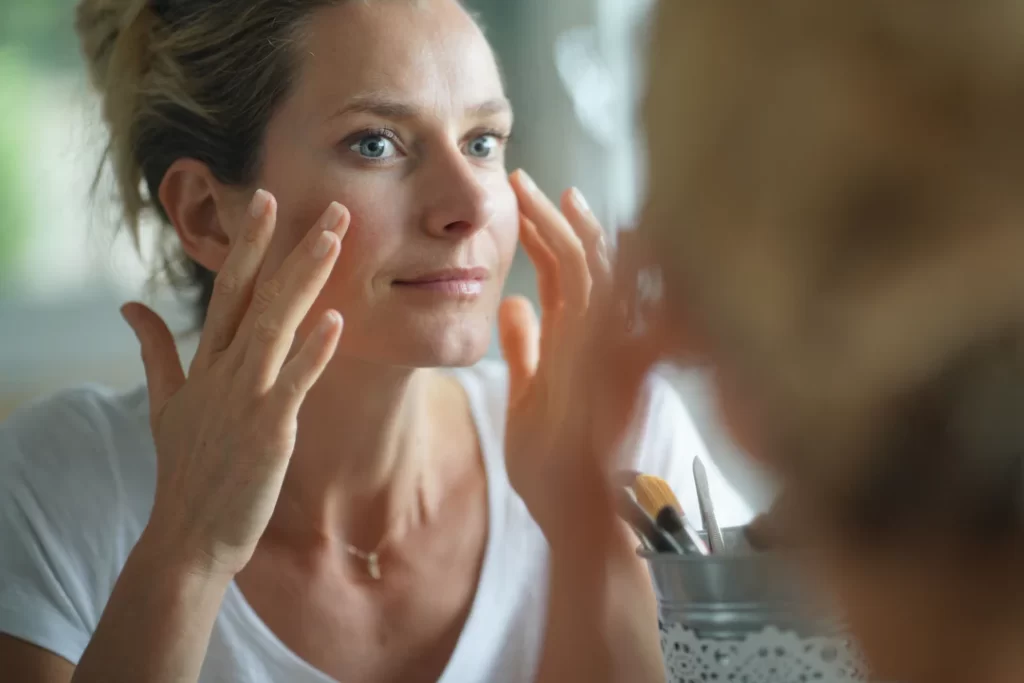
Where Do I Fit Salicylic Acid into My Skincare Routine?
If you’re new to using salicylic acid in your everyday skincare routine, you’ll find it can often feel a little daunting establishing where exactly you should use it and whether it will even fit into a routine you already have.
Salicylic acid is one of the most used beta hydroxy acids (BHA) and often favoured by those who are prone to frequent breakouts, such as spots and blemishes. The way salicylic acid works on the skin varies slightly to the popular alpha hydroxy acids (AHA), such as glycolic acid, because of the fact it has a smaller molecular size meaning it can penetrate further into the skin and reach deep into the pores. Salicylic acid is also oil-soluble meaning it can unclog the pores of a build-up of excess sebum, bacteria, dirt, debris, and other impurities.
Whilst it works in the lower layers of the skin, salicylic acid can rid the outer surface of dead skin cells that if left will build-up over time leading to acne and other breakouts.
If you wanted to know more details about how salicylic acid works on the skin, check out the blog post about the skincare benefits of the clever BHA. You will also find we have a dedicated blog post about using salicylic acid serum in your everyday routine. Now that we have covered what salicylic acid does for the skin, let’s find out together where do you fit salicylic acid into your skincare routine.
Where does salicylic acid go in skincare routine?
This is dependent on the product formula containing salicylic acid as the general skincare rule is to apply your products in order of their consistency, from thinnest to thickest. This is understood to be the most optimal way to reap the rewards of the actives found in your skincare products. Quite often you’ll find salicylic acid is formulated into an array of skincare products, from cleansers, toners, or serums. By choosing which product you decide to use will help you understand where in your routine you can apply salicylic acid in your routine.
Although there are many options, exfoliating toners are known for being the most popular product to use.
This is because toners are highly effective products that can help rid the skin of dead skin cell build-up, dirt, bacteria, and other impurities. The added benefit of using a salicylic acid enriched toner is the fact it does not remain on the skin for an extended amount of time meaning it doesn’t cause any severe dryness or irritation for the skin. As for other skincare products, such as serums or moisturisers, these remain on the skin for a longer amount of time and are applied during the final stages of your daily routine. You will also find that the formulation contains higher concentrates of the powerhouse, so it is advised to only use serums or moisturisers once your skin has built some tolerance for the BHA already. This will help you avoided any unwanted irritation, skin reactions, or severe dryness.
What can you use alongside salicylic acid?
There are several ingredients that can be used alongside salicylic acid.
Glycolic acid
Lactic acid
Malic acid
Hyaluronic acid
Niacinamide
Peptides
Ceramides
Retinol
Vitamin C
Bearing in mind that not all the listed ingredients should be layered with salicylic acid, try applying more potent ingredients such as retinol and glycolic acid during alternate times throughout the day. For example, applying salicylic acid toner during your morning routine will rid the skin of debris build-up, following this with retinol in your evening routine will leave enough time in between to ensure the pH levels in the skin are rebalanced and prepared to absorb other skincare ingredients.
Before you apply any of these formulas to the skin, I strongly recommend you consult with a doctor or dermatologist to find the best product for you and your skin. You can also perform a patch test for 24 hours before applying the product to your face as this will help you avoid any unwanted irritation.
What goes first salicylic acid or hyaluronic acid?
For optimal results try applying salicylic acid first as this will rid the skin of any dead skin cell build-up this will reveal fresh skin that is more absorbent ensuring anything applied to the skin after will penetrate the lower layers of the skin quickly. This is ideal for you to follow this with hyaluronic acid as the humectant traits of this acid will draw moisture into the skin and lock it into place resulting in the skin barrier benefiting from a continuous flow of hydration. This will result in the barrier maintaining good health and the ability to protect the skin from exposure to free radicals, such as pollution, UV rays, central heating, and other environmental aggressors.
How do you introduce salicylic acid? Many find that introducing salicylic acid into their routine is done by starting with an exfoliating toner as this is one of the most effective products that doesn’t cause too much irritation for the skin. Once you have built some tolerance for the powerhouse you can then move on to using a serum enriched in salicylic acid which will have a more potent percentage of the acid in the blend. Remember to apply the salicylic acid product once a week to begin with in the evening to keep the skin away from overexposure to UV rays. This will result in the skin reaping the rewards of the BHA without any side effects. As I have already mentioned, ensure you and your skin are happy with this addition into your routine and try to avoid skin flare-ups, such as breakouts and irritation. Should I use salicylic acid before niacinamide? Yes, you can use salicylic acid before niacinamide. You’ll find niacinamide has similar benefits to the skin as hyaluronic acid, the main difference being its ability to regulate sebum production. This generally means niacinamide is favoured by those prone to acne as it helps hydrate and maintain skin clarity without disrupting salicylic acid from work its magic. There you have a little more information about where to fit salicylic acid into your skincare routine, if you have any further skincare questions come and follow us on Instagram.
DQH Can I use salicylic acid first and then vitamin C?
It’s easy to create a skincare routine, but knowing how to use it is another thing entirely. In most cases, if you’re not getting the desired skin results, it could be due to the layering of conflicting ingredients. So, is it possible that salicylic acid and vitamin C are such ingredients? Or are these active ingredients the duo that’s been missing from your skincare routine? If you want answers, stick around because today we are going to explain the benefits of salicylic acid and vitamin C and how they can be used in your daily life.
What are the benefits of salicylic acid for skin?
Salicylic acid is one of the most commonly used beta hydroxy acids and is favored by many people with oily, acne-prone skin. This acid is derived from willow bark, and unlike its water-soluble relatives (called alpha-hydroxy acids), salicylic acid is oil-soluble, which means it can penetrate deeper into the lower layers of the skin. Once it reaches the lower layers, it can help unclog pores of excess sebum, dirt, bacteria, debris, and impurities. This results in clearer skin tones and greater definition.
Not only does salicylic acid benefit the underlying layers, but the outer surface of the skin benefits as well. When applied to the skin, salicylic acid removes the buildup of dead skin cells. This is accomplished by breaking the bonds that hold dead cells to the surface. Over time, this can cause the complexion to look dull and prone to acne, blackheads, and other blemishes.
If you’d like to learn more about salicylic acid and how it can improve your skin, check out this dedicated blog post from a beauty insider.
What are the benefits of vitamin C for skin?
Vitamin C is considered one of the most powerful antioxidants, which means it is very effective at fighting free radicals and preventing them from causing further skin damage. Examples of free radicals include pollution, central heating, UV rays and harsh climate. They attack proteins, fats and cell membranes as soon as they come into contact with the skin, causing signs of premature aging such as fine lines and wrinkles as well as hyperpigmentation, flaky patches of skin and loss of elasticity.
Many people usually prefer to use vitamin C in their morning routine as this ingredient gives the complexion a radiant glow. You’ll also find that vitamin C can target areas of hyperpigmentation, plumping the skin and reducing the appearance of fine lines and wrinkles.
The thing about vitamin C is that there are a lot of outdated studies going back to the 1950s that describe vitamin C as an unstable skin component. Thanks to improvements in modern technology, this is no longer the case as all products now contain a stable form of vitamin C.
Visit The Beauty Insider to learn more about vitamin C. So please check out our blog post.
Can I use salicylic acid first and then vitamin C?
Yes, you absolutely can. In fact, it’s thought that using salicylic acid before using vitamin C ensures it penetrates faster and works faster.
This is an efficient way to utilize two power sources, and the reason has to do with pH. For example, the skin’s natural pH is about 4.7, making it slightly acidic. Salicylic acid and vitamin C are also both acidic, and you’ll find that vitamin C is absorbed quickly into the skin. Therefore, using salicylic acid beforehand can increase the acidity of the skin and allow vitamin C to penetrate into the skin faster.
While this is considered an effective way to combine two powerful ingredients, you need to be aware of your skin type and how it reacts to certain active ingredients. Even people with perfect, normal skin can experience skin sensitivity and irritation. Therefore, always consult a doctor or dermatologist before using any new products on your skin.
It’s also important to follow skin application rules. In this case, you need to use the product correctly to ensure you get the best results for your skin. If you’re not sure what I mean, the basic rule for skin is to start with the thinnest consistency and work your way up to the thickest consistency. This prevents a barrier from forming on the surface, preventing other active ingredients from penetrating the skin.
Can I use salicylic acid at night and vitamin C in the morning?
Yes, absolutely, this is considered the most effective way to get returns without any adverse side effects. This is because there is enough time between applications to ensure that the skin’s pH levels return to balance.
You’ll also find that Vitamin C is rich in antioxidants and is perfect for use in the morning to ensure your skin is protected and looking its healthiest. Due to the small size of salicylic acid molecules, it is an acid that is able to reach the deepest parts of the skin. While this is effective at keeping skin clear, it also increases the risk of irritation and photosensitivity. Therefore, many people prefer to use powerful BHAs in their evening routine without exposure to UV rays, pollution, or harsh weather.
Warning: If you avoid using sunscreen every day, none of these ingredients will do what your skin needs. The combination of chemical peels and powerful ingredients increases the risk of further damage to the skin’s surface. Use SPF 50 every day to keep your skin protected and your lipid barrier healthy, even on cloudy days, keeping your skin in top condition.


